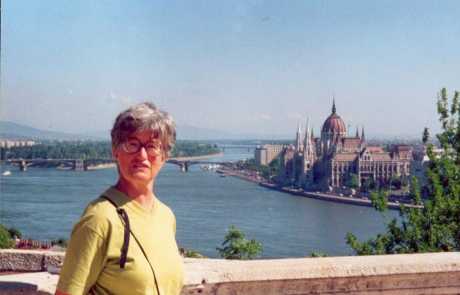
On the Danube in Budapest

On the Danube in Budapest |
Sopron is almost due south of Vienna. The delightful Gothic town is part of a small Hungarian enclave, almost completely surrounded by Austria. We had planned to continue down the Danube to Hungary but our guidebook sang the praises of Sopron that had escaped the ravages of Mongol and Turk invaders and still has a beautiful mediaeval town centre. We also realised that if we did not head south we would see very little the countryside and small towns of Hungary. And we would be able to visit landlocked Hungary's huge inland sea, Lake Balaton. So off we went on a tour of northwest Hungary. We returned briefly to the Danube entering and leaving Budapest and finally crossed it to Slovakia.
The Ride The Road Accommodation Guide Books and Maps Detailed Route Description We used Route 16 in Austria south of Vienna, which connected with the road to Sopron, 6 km from the border. Neither of us, a Swiss and an American (U.S.A.) had any problems at the border nor we did not need visas. The border was at a high point on a small range of hills! Day 2: Sopron to Szombathely via Köszeg. (77 km) We made this detour to visit the small town which is sometimes called the "nation's jewellery box." We biked 26 km out of Sopron on Route 84. We then turned west onto a minor road 51 to Köszeg. Finally 18 km to Szombathely on 87. However the last 10 km were forbidden to cyclists and we took some time to find our way to a village where we found a minor road into the city. Day 3: Szombathely to Héviz (91 km) This was a long frustrating day. We had trouble finding our way, making mistakes looking for towns with long unpronounceable names beginning with "Zed"! We had to climb a few hills, perhaps the worse being at the end of the day into Héviz! Finally there was a strong head wind blowing from the south! We also had to bike illegally for 800 m along busy E 66 looking for our turn onto a minor road.
So, the route we took that day: ( Note minor roads have no numbers) Day 4: Héviz to Balatonfüred (76 km) along Route 71 or the cycle paths whenever possible. A pleasant easy ride among vineyards and low hills. We were north of the icy blue lake all day. Day 5: Balatonfüred to Székesfehérvár (71 km) 17 km along the lake on the bike path at this point old, narrow and bumpy. 12 km after Balatonfüzfä we turned left onto a minor road and climbed high over the lake to Füli and Polgádi. There we turned onto Route 7 that we were told could be used by cyclists. Székesfehérvár is a large town off the tourist routes and we found no budget accommodation. Day 6: Székesfehérvár to Budapest (71 km) We biked out of the city on Route 7 that our map showed as route 70. We were on this road illegally for a while but about 10 km out of town turned onto a minor road, not shown on our map which took us along the south side of Lake Velencei. After the lake we turned back onto 7, (now legal) until the city of Erd. There we were suddenly dumped at an intersection with No Cycling signs on all three roads on either side and in front of us! One was Route 6 and some people in a nearby café directed us onto it and after about 500 m the road turned sharply where a minor road went straight on. We took this and were now within the city limits of Budapest 15 km out of the centre! As soon as we could we turned onto a cycle path along the Danube and with the help of local cyclists reached the Szabatság Bridge and crossed into the centre of Buda. Day 7: Budapest to Esztregom (77 km) We crossed the Chain Bridge to Pest and then followed the cycle route, sometimes along a special path and sometimes on very minor suburban roads, to Szentendre. It was often confusing as it was not well signposted. We continued along a delightful cycle path along the Danube after Szentendre and joined Route 11 29 km before Estregom. This was a quiet but rather narrow main road.
At Esztregom we arrived the day before the new bridge across the Danube to Slovakia was officially opened and blessed by the local Bishop. This replaces the old bridge destroyed during the Second World War. This pilgrimage city has a big cathedral and has been the seat of Hungarian Catholicism for a 1000 years. It has many expensive hotels and pensions so we chose to stand in the very pleasant campsite by the Danube. Early the next morning before the ceremonies got started, we crossed over and began our tour of Slovakia and the Czech Republic.
|